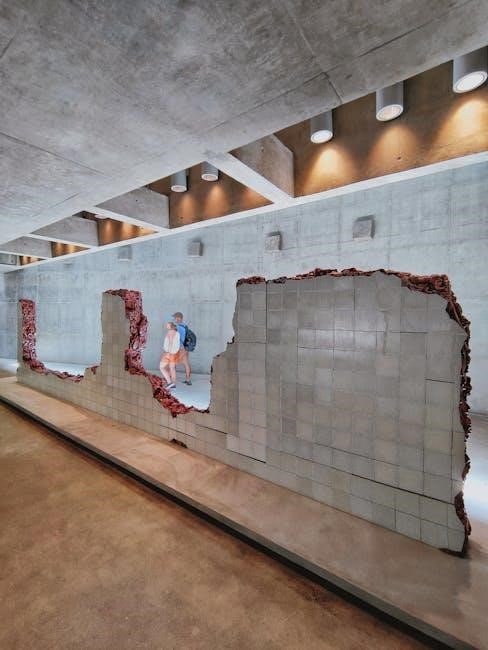Fibre cement sheet installation requires careful planning and execution to ensure a successful project with
proper
techniques and tools always used effectively online.
Importance of Correct Installation
The importance of correct installation of fibre cement sheets cannot be overstated, as it plays a crucial role in ensuring the longevity and durability of the structure. A proper installation will help to prevent water damage, reduce maintenance costs, and provide a safe and healthy environment. Correct installation also ensures that the fibre cement sheets are able to withstand various weather conditions, including heavy rainfall, extreme temperatures, and high winds. Furthermore, a well-installed fibre cement sheet will also enhance the aesthetic appeal of the building, providing a smooth and even finish. By following the recommended installation procedures, individuals can ensure that their fibre cement sheets are installed correctly, providing a strong and durable structure that will last for many years. This is especially important for buildings that are exposed to harsh weather conditions or high traffic areas.
Types of Fibre Cement Sheets
There are various types of fibre cement sheets available, each with its own unique characteristics and uses. These include flat sheets, corrugated sheets, and profiled sheets, among others. The choice of sheet type depends on the specific application, such as roofing, wall construction, or ceiling installation. Some fibre cement sheets are designed for external use, while others are suitable for internal applications. Additionally, some sheets are reinforced with additives to enhance their strength and durability. The different types of fibre cement sheets offer a range of benefits, including resistance to weathering, fire, and pests, as well as low maintenance requirements. By selecting the appropriate type of fibre cement sheet, individuals can ensure that their project meets the required standards and specifications, and that the sheets perform as expected over time. This variety of options allows for flexibility in design and construction.

Pre-Installation Requirements
Pre-installation requirements include site preparation and
planning
with necessary tools and materials always ready online effectively.
Storage and Handling of Fibre Cement Sheets
Proper storage and handling of fibre cement sheets are crucial to prevent damage and ensure a successful installation. The sheets should be stored in a cool, dry, shaded area, away from direct sunlight and moisture. They should be placed on a flat, level surface, with the entire sheet supported to prevent bending or warping. It is also important to protect the sheets from dust, water, and debris. The sheets should be handled with care, avoiding drops or impacts that can cause damage. When storing the sheets, they should be stacked in a way that prevents them from becoming uneven or distorted. By following these guidelines, you can help ensure that your fibre cement sheets arrive at the installation site in good condition, ready to be installed. This will help to prevent delays and costly repairs down the line.
Preparation of the Installation Site
The installation site must be prepared before installing fibre cement sheets. This includes ensuring the site is clean, dry, and free from debris. The area should be cleared of any obstacles or tripping hazards. A level surface is essential for proper installation, so any unevenness must be addressed. The site should also be protected from the weather, with adequate covering to prevent damage from rain or sun. Additionally, all necessary tools and materials should be on site and easily accessible. A well-prepared installation site will help the installation process run smoothly and efficiently, reducing the risk of errors or accidents. By taking the time to properly prepare the site, you can ensure a successful installation and a high-quality finish. This will also help to prevent delays and costly repairs down the line, saving time and money.

Installation Process
Fibre cement sheet installation involves
careful
planning and execution with proper techniques always used effectively online daily.
Laying Fibre Cement Sheets
Laying fibre cement sheets is a crucial step in the installation process, requiring attention to detail and proper technique. The sheets should be laid in a way that minimizes damage and breakages over time. A flat and level surface is essential for a successful installation. The sheets should be aligned properly and spaced evenly to ensure a smooth and even finish. It is also important to consider the direction of the sheets, as they should be laid in a way that allows for easy access and maintenance. By following these guidelines and using the right tools and materials, a successful and professional finish can be achieved. The use of fibre cement sheets can provide a durable and long-lasting solution for various applications, including walls and ceilings. Proper laying techniques are essential for a successful installation.
Jointing and Flashing
Jointing and flashing are critical components of fibre cement sheet installation, ensuring a watertight and durable finish. The joints between sheets should be sealed with a suitable sealant, and flashing should be installed around edges and corners to prevent water ingress. A variety of jointing and flashing techniques can be used, depending on the specific application and design requirements. It is essential to follow the manufacturer’s recommendations for jointing and flashing materials and methods. Proper jointing and flashing can help to prevent common issues such as water damage and structural problems. By using the right materials and techniques, a successful and long-lasting installation can be achieved. The use of fibre cement sheets can provide a reliable and low-maintenance solution for various applications, including walls and ceilings, when jointing and flashing are done correctly. Effective jointing and flashing are vital for a successful installation.

Specific Installation Guides
Guides provide detailed instructions for specific fibre cement products and applications using various
techniques
and materials always.
James Hardie Fibre Cement Installation Guide
The James Hardie fibre cement installation guide is a comprehensive resource that provides detailed instructions for installing James Hardie fibre cement products. This guide is designed to help builders, contractors, and DIY enthusiasts achieve a successful and professional finish with James Hardie fibre cement sheets. The guide covers topics such as preparation, installation, and finishing, and includes tips and recommendations for working with James Hardie fibre cement products. By following the guide, users can ensure that their James Hardie fibre cement installation is done correctly and safely. The guide is available online and can be downloaded or printed for easy reference. It is an essential tool for anyone working with James Hardie fibre cement products and is highly recommended for anyone looking to achieve a high-quality finish. The guide is regularly updated to reflect new products and installation methods.
Villaboard Lining Installation Guide
The Villaboard lining installation guide provides detailed instructions for installing Villaboard lining products, which are designed for internal lining applications. This guide covers the preparation and installation of Villaboard lining sheets, including the use of appropriate tools and materials. The guide is intended for builders, contractors, and DIY enthusiasts who want to achieve a high-quality finish with Villaboard lining products. It includes information on jointing and finishing, as well as tips for working with Villaboard lining sheets. The guide is available online and can be downloaded or printed for easy reference. By following the guide, users can ensure that their Villaboard lining installation is done correctly and safely, and that the finished product meets their expectations. The guide is an essential tool for anyone working with Villaboard lining products. It helps to achieve a professional finish and ensures a successful installation.

and Final Check
Final inspection ensures a successful fibre cement sheet installation with proper techniques and tools used effectively online always.
Troubleshooting Common Issues
Troubleshooting is an essential part of the fibre cement sheet installation process, allowing installers to identify and resolve issues quickly and efficiently. Common problems include uneven sheets, damaged edges, and incorrect jointing. To troubleshoot these issues, installers can refer to the manufacturer’s guidelines and recommendations. Online resources and forums can also provide valuable advice and solutions. By addressing these issues promptly, installers can ensure a successful and professional installation. Effective troubleshooting requires attention to detail, patience, and a thorough understanding of the installation process. With the right approach, installers can overcome common obstacles and achieve a high-quality finish. Troubleshooting is a critical step in ensuring the longevity and performance of fibre cement sheets, and it is essential to get it right. Proper troubleshooting techniques can make all the difference in the final result.
